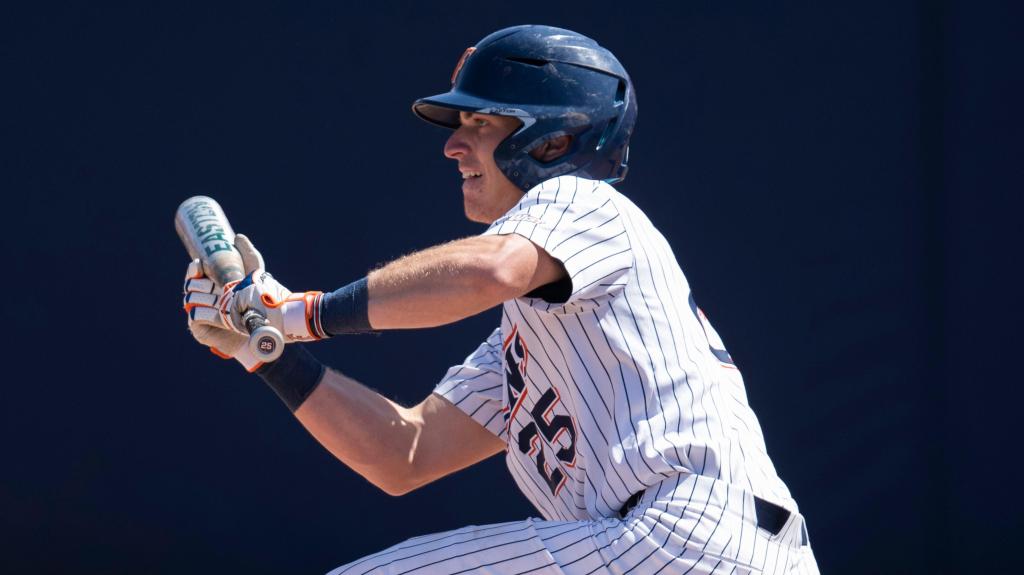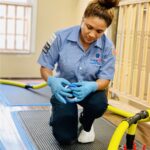
Orioles continue pitching investment, selecting six more college arms – The Denver Post
Last Updated on July 12, 2023 by Admin
[ad_1]

In the 2022 draft, the Orioles used 12 of their 22 selections on pitchers, the organization’s most through 20 rounds of any of the four drafts under executive vice president and general manager Mike Elias.
They topped that in 2023. After selecting seven pitchers through the first 10 rounds Sunday and Monday, including three right-handers in the first four rounds, the Orioles drafted six more college arms on Day 3 for a total of 13 pitchers. The haul marks the 2023 draft as the largest pitching investment the Orioles have made since Elias took over in November 2018.
In the first four drafts under Elias, the Orioles displayed a clear preference for position players in early rounds, and many of them have panned out — from Adley Rutschman to Gunnar Henderson to Colton Cowser. But on Day 1, the Orioles selected Florida State right-hander Jackson Baumeister No. 63 overall, the highest they’ve drafted a pitcher since Grayson Rodriguez in 2018′s first round, before Elias took over.
Baltimore isn’t just focused on the college ranks for pitchers, though. Each of the first five position players the Orioles drafted was also out of college, with their only two high school selections coming in the 15th and 19th rounds.
Elias said after picking Vanderbilt center fielder Enrique Bradfield Jr. No. 17 overall that the condensed, five-round draft in 2020 amid the coronavirus pandemic created a deeper class this summer, as many of the high schoolers who could have been selected in 2020 instead went to college and are now eligible again for the first time.
In total, the Orioles used their 22 picks to select 13 college pitchers, seven college position players (five outfielders, one infielder, one catcher) and two high schoolers (one outfielder, one infielder).
Baltimore’s director of draft operations Brad Ciolek said Tuesday evening that the organization likes the “upside” of the Orioles’ 2023 class.
“I just want to say that I’m very excited to add another 10 players today to our 2023 draft class,” Ciolek said. “It’s a dynamic group as far as athleticism is concerned. There’s a lot of upside with all these guys, and as far as the makeup is concerned, it’s a very strong group. We’re very excited to add to the crop that we have and continue to bolster our farm system.”
Here’s a breakdown of Baltimore’s selections from the third day of the MLB draft, with input from Ciolek on several of the players.
Round 11 (331 overall): Seattle right-hander Nestor German
Skinny: After ending Day 2 by taking four pitchers with their final five picks, the Orioles continued their run on college arms with the first pick on Day 3 by selecting German. At 6 feet 3, German had a career ERA of 6.37 with a below-average 15.9% strikeout rate during his three years at Seattle University, a small Division I school in the Western Athletic Conference. However, German, 21, had his best season in 2023, improving his strikeout rate considerably to punch out 74 batters in 78 1/3 innings.
Round 12 (361 overall): LSU right-hander Blake Money
Skinny: On Day 3 last year, the Orioles selected Jared Beck, a 7-foot right-hander out of Saint Leo University. Money isn’t anywhere near 7 feet tall, but at 6-7, he was one of the tallest pitchers in this year’s draft class and is the tallest pitcher Baltimore selected in the 2023 draft. During his three seasons at LSU, Money had a 6.26 ERA and struck out 8.6 batters per nine innings. After pitching out of the Tigers’ rotation in 2022, he was converted to a relief role in 2023. Baseball America ranked him as the 439th-best prospect in the draft pool.
Ciolek’s take: “We do envision him as a starter. The fastball and slider play extremely well. We’re going to look to stretch him out, get him more innings.”
Round 13 (391 overall): LSU left-hander Riley Cooper
Skinny: After each of the first nine pitchers the Orioles selected were right-handers, they took a left-handed reliever in Cooper, drafting an LSU arm with back-to-back picks. The strike-thrower spent his freshman season at Arizona before transferring to LSU in 2022. In his career, the 21-year-old went 12-6 with a 4.44 ERA in 91 appearances (six starts). His best season came this spring, as the 6-2, 270-pound southpaw struck out 63 batters in 61 2/3 innings.
Ciolek’s take: “Anytime you have the opportunity to add power arms, guys that have some pitchability from the SEC, that’s always a focal point for us. … Riley Cooper is a fierce competitor. We do like his pitchability, his changeup is very effective as well, and he’s got a four-pitch mix. Just the fact that those guys have been on a championship club, the championship pedigree that goes along with that, and they’re fierce competitors. We think that will carry over well here in our system.”
Round 14 (421 overall): State College of Florida Manatee-Sarasota right-hander Michael Forret
Skinny: On Day 2, Baltimore drafted multiple players who began their college careers at the junior college level. With Forret, they took one straight from a JUCO near their spring training facility in Sarasota, Florida. In 86 1/3 innings this spring, the 6-3 19-year-old struck out 106 batters, sporting a low-90s mph fastball.
Round 15 (451 overall): Lowndes High School (Ga.) outfielder Qrey Lott
Skinny: Lott ended the Orioles’ college player streak. After selecting 16 straight players out of college, Baltimore drafted the 6-4, 175-pound high schooler from Georgia. The 18-year-old is committed to play for Northwest Florida State College.
Ciolek’s take: “Qrey is a quick-twitch athlete. There’s a lot of upside here. He’s a slam-dunk center fielder, can really run, he’s got a plus arm, and we think that there’s some more projection down the road to add some weight and strength to his frame where we can tap into some power.”
Round 16 (481 overall): Cal State Fullerton catcher Cole Urman
Skinny: Many of the 13 pitchers joining the organization will throw to Urman during their minor league careers. In his three years at Cal State Fullerton, Urman, seen as a plus-defender, hit .254 with a below-average .625 OPS. However, his offense improved this spring, as the 21-year-old hit .270 with four home runs and nine doubles in 49 games.
Round 17 (511 overall): Hillsdale College right-hander Zane Barnhart
Skinny: A Towson native, Barnhart dominated as a reliever at the Division II level. The 5-10 21-year-old posted a 2.06 ERA in 43 2/3 innings for Hillsdale this spring, striking out 61 and walking just 10. Barnhart joins Forret as the only non-Division I players taken by the Orioles in the 2023 draft, although the former had transferred to West Virginia to potentially play his senior season there in 2024 if he doesn’t sign with Baltimore.
Round 18 (541 overall): Texas right-hander Tanner Witt
Skinny: Witt, who turned 21 on Tuesday, was a top prospect coming out of high school in 2020, but he announced before the draft his intention to play for the Longhorns. As a freshman, he excelled out of Texas’ bullpen with a 3.16 ERA and 73 strikeouts in 57 innings. Early in 2022, though, he tore his ulnar collateral ligament and underwent Tommy John elbow reconstruction. He returned in 2023 and struggled, allowing 13 runs in 10 2/3 innings. Witt, the son of former major league first baseman Kevin Witt, entered the 2023 draft ranked as the 76th-best prospect in the draft pool, according to MLB Pipeline, and No. 122 on Baseball America’s list. Given Witt’s poor performance this spring coming off Tommy John, it might be difficult for the Orioles to sign the 6-6 pitcher, although Baltimore was able to get Vanderbilt’s Carter Young under contract after taking the shortstop in the 17th round last summer.
Ciolek’s take: “Obviously, the goal for us is to try to put our best foot forward, signing each and every one of these guys. I won’t specifically go into any negotiation talks, try to keep all of that under wraps until a deal is done, but I’ll just say the goal is obviously to sign each and every one of these guys.”
Round 19 (571 overall): Atoka High School (Okla.) shortstop Kollin Ritchie
Skinny: Ritchie was the second and final high schooler the Orioles drafted, and similar to Witt, it might be difficult for Baltimore to sign the 18-year-old shortstop. Ritchie, who hits left-handed, is committed to Oklahoma State and entered the draft rated by MLB Pipeline as the No. 214 prospect in the pool and No. 400 by Baseball America.
Ciolek’s take: “Kollin Ritchie is a guy that we actually had here for a workout. A left-handed hitter with plus power, he’s got great bat-to-ball skills, also has a pristine eye at the plate. I believe he broke the Oklahoma state high school record for walks.”
Round 20 (601 overall): North Greenville University shortstop Jalen Vasquez
Skinny: After going 20 picks without drafting an infielder, the Orioles used their final two picks on shortstops, following up the Ritchie selection by taking Vasquez. The 21-year-old spent the first two years of his college career with South Carolina, barely playing in 2021 and hitting just .226 in 2022. He transferred to Division II North Greenville University for the 2023 campaign and dominated, slashing .332/.444/.624 — good for a 1.068 OPS.
Other notable selections
After four University of Maryland players were drafted in the first 10 rounds, two more Terps were taken on Day 3.
Right-handed pitcher Nigel Belgrave and left-hander Tommy Kane joined shortstop Matt Shaw (No. 13 overall, Chicago Cubs), catcher Luke Shliger (No. 180, San Francisco Giants), right-hander Jason Savacool (No. 185, St. Louis Cardinals) and third baseman Nick Lorusso (No. 276, New York Mets) as Terps players selected.
Belgrave, who struck out 68 batters in 51 2/3 career innings with a 6.79 ERA, was drafted in the 15th round by the Miami Marlins. Kane, who posted a 7.31 ERA in 28 1/3 innings with 29 strikeouts in his lone season with the Terps, was selected in the 19th round by the Giants.
()
[ad_2]
Source link




